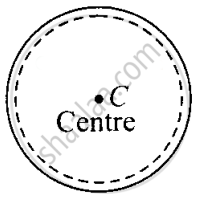Advertisements
Advertisements
प्रश्न
For which of the following does the centre of mass lie outside the body?
विकल्प
A pencil
A shotput
A dice
A bangle
उत्तर
A bangle
Explanation:
The Center of mass of a system (body) is a point that moves as though all the mass were concentrated there and all external forces were applied there.
Important points about the center of Mass:
(i) The position of center of mass is independent of the coordinate system chosen.
(ii) The position of center of mass depends upon the shape of the body and the distribution of mass.
Example: The center of mass of a circular disc is within the material of the body while that of a circular ring is outside the material of the body.
(iii) We can imagine a rigid body also as a system of masses and hence every rigid body has a center of mass. In the case of a regularly shaped uniform rigid body, center of mass is simply the geometric centre of the body.
A bangle is in the form of a ring as shown in the diagram below. We know that the position of center of mass depends upon the shape of the body and the distribution of mass. So, out of four given bodies, the centre of mass lies at the centre, which is outside the body (boundary) whereas in all other three bodies it lies within the body because they are completely solid.

APPEARS IN
संबंधित प्रश्न
Consider the following the equations
(A) \[\vec{R} = \frac{1}{M} \sum_i m_i \vec{r_i}\] and
(B) \[\vec{a}_{CM} = \frac{\vec{F}}{M}\]
In a noninertial frame
Consider a system of two identical particles. One of the particles is at rest and the other has an acceleration a. The centre of mass has an Acceleration
In which of the following cases the centre of mass of a rod is certainly not at its centre?
(a) the density continuously increases from left to right
(b) the density continuously decreases from left to right
(c) the density decreases from left to right upto the centre and then increases
(d) the density increases from left to right upto the centre and then decreases.
A square plate of edge d and a circular disc of diameter d are placed touching each other at the midpoint of an edge of the plate as shown in figure. Locate the centre of mass of the combination, assuming same mass per unit area for the two plates.
Find the centre of mass of a uniform plate having semicircular inner and outer boundaries of radii R1 and R2.

Mr. Verma (50 kg) and Mr. Mathur (60 kg) are sitting at the two extremes of a 4 m long boat (40 kg) standing still in water. To discuss a mechanics problem, they come to the middle of the boat. Neglecting friction with water, how far does the boat move on the water during the process?
Find the ratio of the linear momenta of two particles of masses 1.0 kg and 4.0 kg if their kinetic energies are equal.
Three equal masses each of 50 g, are placed at the corners of a right angled isosceles triangle whose two equal sides are 5 cm each. The position of the centre of mass of the system is ____________.
The mass per unit length of a non-uniform rod of length L varies as m = λx where λ is constant. The centre of mass of the rod will be at ______.
The spheres of masses 2 kg and 4 kg are situated at the opposite ends of wooden bars of length 9 m. Where does the centre of mass of the system will ______.
